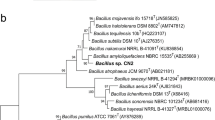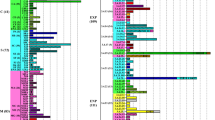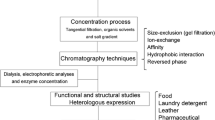Abstract
Arthrospira platensis is rich in branched-chain amino acids (BCAAs) and serves as a promising alternative material for BCAA-containing peptide production. Herein, Arthrospira platensis whole protein was employed for BCAA-containing peptide preparation by determining BCAA contents of whole protein and C-phycocyanin and allophycocyanin subunits. Released peptidome profiles by different types of proteases were significantly gathered into three clusters through principal component analysis, with only 39 shared sequences in the identified peptidomes, in which the portfolio by papain contained the highest number of BCAA-containing peptides, accounting for a proportion over 95%. A portfolio of 569 peptides with differential abundances among the peptidomes by papain with increased hydrolysis time showed a dynamic change trend, corresponding to the degradation of long peptides into oligopeptides. Therefore, BCAA-containing peptides released from Arthrospira platensis depended on hydrolysis conditions, and changes in BCAA-containing peptidomes were monitored through a peptidomics workflow, contributing to the quality control of target peptides.






Similar content being viewed by others
Data Availability
Data will be made available on request.
Abbreviations
- BCAA:
-
Branched-chain amino acid
- FDR:
-
False discovery rate
- ANOVA:
-
Analysis of variance
- C-PC:
-
C-phycocyanin
- APC:
-
Allophycocyanin
- PCA:
-
Principal component analysis
- PC:
-
Principal component
References
Agyei, D., Tsopmo, A., & Udenigwe, C. C. (2018). Bioinformatics and peptidomics approaches to the discovery and analysis of food-derived bioactive peptides. Analytical and Bioanalytical Chemistry, 410(15), 3463–3472. https://doi.org/10.1007/s00216-018-0974-1
Aiello, G., Li, Y. C., Boschin, G., Bollati, C., Arnoldi, A., & Lammi, C. (2019). Chemical and biological characterization of spirulina protein hydrolysates: Focus on ACE and DPP-IV activities modulation. Journal of Functional Foods, 63, 103592. https://doi.org/10.1016/j.jff.2019.103592
Aouir, A., Amiali, M., Bitam, A., Benchabane, A., & Raghavan, V. G. (2017). Comparison of the biochemical composition of different Arthrospira platensis strains from Algeria, Chad and the USA. Journal of Food Measurement and Characterization, 11(2), 913–923. https://doi.org/10.1007/s11694-016-9463-4
Barkia, I., Saari, N., & Manning, S. R. (2019). Microalgae for high-value products towards human health and nutrition. Marine Drugs, 17(5), 304. https://doi.org/10.3390/md17050304
Bleakley, S., & Hayes, M. (2017). Algal proteins: Extraction, application, and challenges concerning production. Foods, 6(5), 33. https://doi.org/10.3390/foods6050033
Bocker, L., Hostettler, T., Diener, M., Eder, S., Demuth, T., Adamcik, J., Reineke, K., Leeb, E., Nystrom, L., & Mathys, A. (2020). Time-temperature-resolved functional and structural changes of phycocyanin extracted from Arthrospira platensis/Spirulina. Food Chemistry, 316, 126374. https://doi.org/10.1016/j.foodchem.2020.126374
Cassidy, L., Kaulich, P. T., & Tholey, A. (2019). Depletion of high-molecular-mass proteins for the identification of small proteins and short open reading frame encoded peptides in cellular proteomes. Journal of Proteome Research, 18(4), 1725–1734. https://doi.org/10.1021/acs.jproteome.8b00948
Chen, W., Su, H., Xu, Y., Bao, T., & Zheng, X. (2016). Protective effect of wild raspberry (Rubus hirsutus Thunb) extract against acrylamide-induced oxidativedamage is potentiated after simulated gastrointestinal digestion. Food Chemistry, 196, 943–952. https://doi.org/10.1016/j.foodchem.2015.10.024
Chen, Y. H., Liang, H. H., Du, H., Jesumani, V., He, W. L., Cheong, K. L., Li, T. C., & Hong, T. (2022). Industry chain and challenges of microalgal food industry-a review. Critical Reviews in Food Science and Nutrition. https://doi.org/10.1080/10408398.2022.2145455
da Cruz, C. Z. P., de Mendonca, R. J., Guimaraes, L. H. S., Ramos, M. A. D., Garrido, S. S., de Paula, A. V., Monti, R., & Massolini, G. (2020). Assessment of the bioactive potential of cheese whey protein hydrolysates using immobilized alcalase. Food and Bioprocess Technology, 13(12), 2120–2130. https://doi.org/10.1007/s11947-020-02552-4
dos Santos, S. D., Martins, V. G., Salas-Mellado, M., & Prentice, C. (2011). Evaluation of functional properties in protein hydrolysates from Bluewing searobin (Prionotus punctatus) obtained with different microbial enzymes. Food and Bioprocess Technology, 4(8), 1399–1406. https://doi.org/10.1007/s11947-009-0301-0
Dullius, A., Fassina, P., Giroldi, M., Goettert, M. I., & de Souza, C. F. V. (2020). A biotechnological approach for the production of branched chain amino acid containing bioactive peptides to improve human health: A review. Food Research International, 131, 109002. https://doi.org/10.1016/j.foodres.2020.109002
Fan, X. D., Cui, Y. J., Zhang, R. L., & Zhang, X. W. (2018). Purification and identification of anti-obesity peptides derived from Spirulina platensis. Journal of Functional Foods, 47, 350–360. https://doi.org/10.1016/j.jff.2018.05.066
Huang, Y. P., Dias, F. F. G., Bell, J., & Barile, D. (2022). A complete workflow for discovering small bioactive peptides in foods by LC-MS/MS: A case study on almonds. Food Chemistry, 369, 130834. https://doi.org/10.1016/j.foodchem.2021.130834
Ishak, N. H., & Sarbon, N. M. (2018). A review of protein hydrolysates and bioactive peptides deriving from wastes generated by fish processing. Food and Bioprocess Technology, 11(1), 2–16. https://doi.org/10.1007/s11947-017-1940-1
Khaldi, N., Vijayakumar, V., Dallas, D. C., Guerrero, A., Wickramasinghe, S., Smilowitz, J. T., Medrano, J. F., Lebrilla, C. B., Shields, D. C., & German, J. B. (2014). Predicting the important enzymes in human breast milk digestion. Journal of Agricultural and Food Chemistry, 62(29), 7225–7232. https://doi.org/10.1021/jf405601e
Kim, S. B., Seo, I. S., Khan, M. A., Ki, K. S., Lee, W. S., Lee, H. J., Shin, H. S., & Kim, H. S. (2007). Enzymatic hydrolysis of heated whey: Iron-binding ability of peptides and antigenic protein fractions. Journal of Dairy Science, 90(9), 4033–4042. https://doi.org/10.3168/jds.2007-0228
Kobayashi, Y., Somoto, Y., Mitsuyama, E., Tanaka, A., Yuda, N., Nakada, H., Yamada, A., Yamauchi, K., Abe, F., & Nagasawa, T. (2016). Supplementation of protein-free diet with whey protein hydrolysates prevents skeletal muscle mass loss in rats. Journal of Nutrition & Intermediary Metabolism, 4, 1–5. https://doi.org/10.1016/j.jnim.2016.03.001
Kumar, A., Hanjabam, M. D., Kishore, P., Uchoi, D., Panda, S. K., Mohan, C. O., Chatterjee, N. S., Zynudheen, A. A., & Ravishankar, C. N. (2023). Exploitation of seaweed functionality for the development of food products. Food and Bioprocess Technology. https://doi.org/10.1007/s11947-023-03023-2
Laosam, P., Panpipat, W., Chaijan, M., Roytrakul, S., Charoenlappanit, S., Panya, A., Phonsatta, N., Cheong, L. Z., & Yusakul, G. (2022). Molecular structures and in vitro bioactivities of enzymatically produced porcine placenta peptides fractionated by ultrafiltration. Food and Bioprocess Technology, 15(3), 669–682. https://doi.org/10.1007/s11947-022-02781-9
Li, Y. C., Aiello, G., Bollati, C., Bartolomei, M., Arnoldi, A., & Lammi, C. (2020). Phycobiliproteins from Arthrospira Platensis (Spirulina): A new source of peptides with dipeptidyl peptidase-IV inhibitory activity. Nutrients, 12(3), 794. https://doi.org/10.3390/nu12030794
Martini, S., Solieri, L., & Tagliazucchi, D. (2021). Peptidomics: New trends in food science. Current Opinion in Food Science, 39, 51–59. https://doi.org/10.1016/j.cofs.2020.12.016
Minkiewicz, P., Iwaniak, A., & Darewicz, M. (2019). BIOPEP-UWM database of bioactive peptides: Current opportunities. International Journal of Molecular Sciences, 20(23), 5978. https://doi.org/10.3390/ijms20235978
Morifuji, M., Ishizaka, M., Baba, S., Fukuda, K., Matsumoto, H., Koga, J., Kanegae, M., & Higuchi, M. (2010). Comparison of different sources and degrees of hydrolysis of dietary protein: Effect on plasma amino acids, dipeptides, and insulin responses in human subjects. Journal of Agricultural and Food Chemistry, 58(15), 8788–8797. https://doi.org/10.1021/jf101912n
Naghdi, S., Lorenzo, J. M., Mirnejad, R., Ahmadvand, M., & Moghaddam, M. M. (2023). Bioactivity evaluation of peptide fractions from bighead carp (Hypophthalmichthys nobilis) using alcalase and hydrolytic enzymes extracted from Oncorhynchus mykiss and their potential to develop the edible coats. Food and Bioprocess Technology, 16, 1128–1148. https://doi.org/10.1007/s11947-022-02986-y
Nie, C. X., He, T., Zhang, W. J., Zhang, G. L., & Ma, X. (2018). Branched chain amino acids: Beyond nutrition metabolism. International Journal of Molecular Sciences, 19(4), 954. https://doi.org/10.3390/ijms19040954
Olatunde, O. O., Owolabi, I. O., Fadairo, O. S., Ghosal, A., Coker, O. J., Soladoye, O. P., Aluko, R. E., & Bandara, N. (2022). Enzymatic modification of plant proteins for improved functional and bioactive properties. Food and Bioprocess Technology, 16, 1216–1234. https://doi.org/10.1007/s11947-022-02971-5
Rasool, M., & Sabina, E. P. (2009). Appraisal of immunomodulatory potential of Spirulina fusiformis: An in vivo and in vitro study. Journal of Natural Medicines, 63(2), 169–175. https://doi.org/10.1007/s11418-008-0308-2
Rieu, I., Sornet, C., Bayle, G., Prugnaud, J., Pouyet, C., Balage, M., Papet, I., Grizard, J., & Dardevet, D. (2003). Leucine-supplemented meal feeding for ten days beneficially affects postprandial muscle protein synthesis in old rats. Journal of Nutrition, 133(4), 1198–1205. https://doi.org/10.1093/jn/133.4.1198
Sotiroudis, T. G., & Sotiroudis, G. T. (2013). Health aspects of Spirulina (Arthrospira) microalga food supplement. Journal of the Serbian Chemical Society, 78(3), 395–405. https://doi.org/10.2298/jsc121020152s
Storer, A. C., & Menard, R. (1996). Recent insights into cysteine protease specificity: Lessons for drug design. Perspectives in Drug Discovery and Design, 6, 33–46. https://doi.org/10.1007/BF02174044
Sugawara, T., Ito, Y., Nishizawa, N., & Nagasawa, T. (2009). Regulation of muscle protein degradation, not synthesis, by dietary leucine in rats fed a protein-deficient diet. Amino Acids, 37(4), 609–616. https://doi.org/10.1007/s00726-008-0180-0
Tan, H. T., Khong, N. M. H., Khaw, Y. S., Ahmad, S. A., & Yusoff, F. M. (2020). Optimization of the freezing-thawing method for extracting phycobiliproteins from Arthrospira sp. Molecules, 25(17), 3894. https://doi.org/10.3390/molecules25173894
Wang, Q., Wang, Y. C., Jiang, X. M., Ma, L., Li, Z. J., Chang, Y. G., Wang, Y. M., & Xue, C. H. (2021). Amino acid profiling with chemometric analysis as a feasible tool for the discrimination of marine-derived peptide powders. Foods, 10(6), 1294. https://doi.org/10.3390/foods10061294
Wang, Y. C., Chang, Y. G., Yin, L., Xue, Y., Li, Z. J., & Xue, C. H. (2016). A novel technological process of extracting l-tyrosine with low fluorine content from defatted antarctic krill (Euphausia superba) by-product by enzymatic hydrolysis. Food and Bioprocess Technology, 9(4), 621–627. https://doi.org/10.1007/s11947-015-1658-x
Wu, M., Liu, S., & Li, B. (2010). Preparation and purification of low-molecular-weight peptides from Spirulina protein. Acta Agriculturae Zhejiangensis, 22(6), 802–807.
Wu, Q. H., Liu, L., Miron, A., Klimova, B., Wan, D., & Kuca, K. (2016). The antioxidant, immunomodulatory, and anti-inflammatory activities of Spirulina: An overview. Archives of Toxicology, 90(8), 1817–1840. https://doi.org/10.1007/s00204-016-1744-5
Xiong, K., Liu, J. Y., Wang, X. Y., Sun, B. G., Zhao, Z. Y., Pei, P. G., & Li, X. Y. (2022). Preparation of high Fischer ratio oligopeptide of chlorella powder using specific enzymatic hydrolysis. Food Science and Technology, 42. https://doi.org/10.1590/fst.42220
Zhang, B. C., & Zhang, X. W. (2013). Separation and nanoencapsulation of antitumor polypeptide from Spirulina platensis. Biotechnology Progress, 29(5), 1230–1238. https://doi.org/10.1002/btpr.1769
Zhang, W. H., Jia, N., Zhu, Z. H., Wang, Y. C., Wang, J. F., & Xue, C. H. (2021). Changes of antioxidative activities and peptidomic patterns of Auxenochlorella pyrenoidosa protein hydrolysates: Effects of enzymatic hydrolysis and decoloration processes. Lwt-Food Science and Technology, 152, 112306. https://doi.org/10.1016/j.lwt.2021.112306
Ziegler, F., Ollivier, J. M., Cynober, L., Masini, J. P., Coudraylucas, C., Levy, E., & Giboudeau, J. (1990). Efficiency of enteral nitrogen support in surgical patients: Small peptides v non-degraded proteins. Gut, 31(11), 1277–1283. https://doi.org/10.1136/gut.31.11.1277
Funding
This work was supported by National Natural Science Foundation of China (32272262) and Youth Innovation Technology Project of Higher School in Shandong Province (2021KJ090).
Author information
Authors and Affiliations
Contributions
Yinuo Guo: methodology, investigation, data curation, formal analysis, and writing—original draft. Linrong Wu: investigation and data curation. Zihao Zhu: formal analysis and data curation. Hu Hou: writing—review and editing. Yanchao Wang: conceptualization, methodology, formal analysis, funding acquisition, supervision, project administration, and writing—review and editing.
Corresponding author
Ethics declarations
Competing Interest
The authors declare no competing interests.
Additional information
Publisher's Note
Springer Nature remains neutral with regard to jurisdictional claims in published maps and institutional affiliations.
Highlights
• Target peptide with branched-chain amino acid is prepared from Arthrospira platensis.
• Whole protein is more suitable for target peptide production than primary components.
• Change of peptidome during hydrolysis is monitored through a peptidomics workflow.
• The peptidome by papain contains more target peptides with a proportion over 95%.
• A portfolio of 569 peptides with differential abundances changed with increased time.
Supplementary Information
Below is the link to the electronic supplementary material.
Rights and permissions
Springer Nature or its licensor (e.g. a society or other partner) holds exclusive rights to this article under a publishing agreement with the author(s) or other rightsholder(s); author self-archiving of the accepted manuscript version of this article is solely governed by the terms of such publishing agreement and applicable law.
About this article
Cite this article
Guo, Y., Wu, L., Zhu, Z. et al. Investigation of Peptides Containing Branched-Chain Amino Acids from Arthrospira platensis Through A Peptidomics Workflow. Food Bioprocess Technol 17, 516–527 (2024). https://doi.org/10.1007/s11947-023-03147-5
Received:
Accepted:
Published:
Issue Date:
DOI: https://doi.org/10.1007/s11947-023-03147-5




